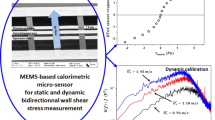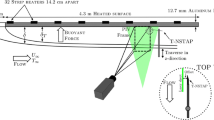Abstract
Multi-element hot-wire anemometry was used to measure spanwise vorticity fluctuations in turbulent boundary layers. Smooth wall boundary layer profiles, with very good spatial and temporal resolution, were acquired over a Kármán number range of 2000–12,700 at the Melbourne Wind Tunnel at the University of Melbourne and the University of New Hampshire’s Flow Physics Facility. A custom hot-wire probe was necessary to simultaneously obtain velocity and spanwise vorticity measurements centered at a fixed point in space. A custom calibration/processing scheme was developed to utilize single-wall-parallel wires to optimize the accuracy of the measured wall-normal velocity fluctuations derived from the sensor’s \(\times\)-array.











Similar content being viewed by others
References
Abdel-Rahman AA, Hitchman GJ, Slawson PR, Strong AB (1989) An X-array hot-wire technique for heated turbulent flows of low velocity. J Phys E Sci Instrum 22(8):638
Adrian RJ, Westerweel J (2011) Particle image velocimetry. Cambridge University Press, Cambridge
Bakken OM, Krogstad P (2004) A velocity dependent effective angle method for calibration of X-probes at low velocities. Exp Fluids 37:146–152
Bradshaw P (1971) An introduction to turbulence and its measurement. Pergamon Press, Oxford
Bruun HH (1995) Hot wire anemometry: principles and signal analysis. Oxford University Press, Oxford
Burattini P, Antonia RA (2005) The effect of different X-wire calibration schemes on some turbulence statistics. Exp Fluids 38(1):80–89
Chauhan KA, Monkewitz PA, Nagib HM (2009) Criteria for assessing experiments in zero pressure gradient boundary layers. Fluid Dyn Res 41(2):021404
Chew YT, Ha SM (1990) A critical evaluation of the explicit data analysis algorithm for a crossed wire anemometer in highly turbulent isotropic flow. Meas Sci Technol 1(8):775
Chin C, Philip J, Klewicki JC, Ooi A, Marusic I (2014) Reynolds-number-dependent turbulent inertia and onset of log region in pipe flows. J Fluid Mech 757:747–769
de Silva CM (2014) Large-scale PIV measurements at high Reynolds numbers in wall-bounded turbulence. PhD thesis, University of Melbourne
DeGraaff D, Eaton J (2000) Reynolds-number scaling of the flat-plate turbulent boundary layer. J Fluid Mech 422:319–346
Ebner R (2014) Influences of Roughness on the Inertial Mechanism of Turbulent Boundary-Layer Scale Separation. Ph.D. thesis, University of New Hampshire
Fife P, Klewicki J, McMurtry P, Wei T (2005) Multiscaling in the presence of indeterminancy: wall-induced turbulence. Multiscale Model Simul 4:936
Folz A, James M (2010) Wallace. Near-surface turbulence in the atmospheric boundary layer. Phys D Nonlinear Phenom 239(14):1305–1317
Foss JF, Haw RC (1990) Transverse vorticity measurements using a compact array of four sensors, vol 97. In: Symposium on Thermal Anemometry, ASME FED
Hinze J (1975) Turbulence. McGraw-Hill, New York
Hutchins N, Nickels TB, Marusic I, Chong MS (2009) Hot-wire spatial resolution issues in wall-bounded turbulence. J Fluid Mech 635:103–136
Johnson FD, Eckelmann H (1984) A variable angle method of calibration for X-probes applied to wall-bounded turbulent shear flow. Exp Fluids 2(3):121–130
Jorgensen FE (1971) Directional sensitivity of wire and fiber-film probes. DISA Inf 11(3):1–7
Khoo BC, Chew YT, Lim CP, Teo CJ (1998) Dynamic response of a hot-wire anemometer. part i: a marginally elevated hot-wire probe for near-wall velocity measurements. Meas Sci Technol 9(5):751
Klewicki JC (2013) A description of turbulent wall-flow vorticity consistent with mean dynamics. J Fluid Mech 737:176–204
Klewicki JC, Falco RE (1990) On accurately measuring statistics associated with small-scale structure in turbulent boundary layers using hot-wire probes. J Fluid Mech 219:119–142
Klewicki JC, Fife P, Wei T (2009) On the logarithmic mean profile. J Fluid Mech 638:73–93
Klewicki JC, Philip J, Marusic I, Chauhan K, Morrill-Winter C (2014) Self-similarity in the inertial region of wall turbulence. Phys Rev E 90(6):063015
Kline SJ, Reynolds WC, Schraub FA, Runstadler PW (1967) The structure of turbulent boundary layers. J Fluid Mech 30(04):741–773
Kulandaivelu V (2011) Evolution and structure of zero pressure gradient turbulent boundary layer. Ph.D. thesis, University of Melbourne
Kunkel GJ, Marusic I (2006) Study of the near-wall-turbulent region of the high-Reynolds-number boundary layer using an atmospheric flow. J Fluid Mech 548:375–402
Lawson RE, Britter RE (1983) A note on the measurement of transverse velocity fluctuations with heated cylindrical sensors at small mean velocities. J Phys E Sci Instrum 16(6):563
Ligrani PM, Bradshaw P (1987) Spatial resolution and measurement of turbulence in the viscous sublayer using subminiature hot-wire probes. Exp Fluids 5(6):407–417
Lueptow RM, Breuer KS, Haritonidis JH (1988) Computer-aided calibration of X-probes using a look-up table. Exp Fluids 6(2):115–118
Marusic I, Monty J, Hultmark M, Smits A (2013) On the logarithmic region in wall turbulence. J Fluid Mech 716:R3
Metzger MM, Klewicki JC (2001) A comparative study of near-wall turbulence in high and low Reynolds number boundary layers. Phys Fluids (1994-present) 13(3):692–701
Morrill-Winter C, Klewicki J (2013) Influences of boundary layer scale separation on the vorticity transport contribution to turbulent inertia. Phys Fluids 25
Morrison GL, Perry AE, Samuel AE (1972) Dynamic calibration of inclined and crossed hot wires. J Fluid Mech 52(03):465–474
Nickels TB, Marusic I, Hafez S, Chong MS (2005) Evidence of the \(k_1^{-1}\) law in a high-reynolds-number turbulent boundary layer. Phys Rev Lett 95(7):074501
Nickels TB, Marusic I, Hafez S, Hutchins N, Chong MS (2007) Some predictions of the attached eddy model for a high reynolds number boundary layer. Philos Trans R Soc A Math Phys Eng Sci 365(1852):807–822
Ong L, Wallace J (1996) The velocity field of the turbulent very near wake of a circular cylinder. Exp Fluids 20(6):441–453
Osterlund JM (1999) Experimental studies of zero pressure-gradient turbulent boundary-layer flow. Ph.D. thesis, Royal Institute of Technology, Stockholm, Sweden
Perry AE (1982) Hot wire anemometry. Clarendon Press, UK
Perry AE, Morrison GL (1971) Static and dynamic calibrations of constant-temperature hot-wire systems. J Fluid Mech 47(04):765–777
Perry AE, Chong MS (1982) On the mechanisms of wall turbulence. J Fluid Mech 119:173–217
Priyadarshana PJA, Klewicki JC, Treat S, Foss JF (2007) Statistical structure of turbulent-boundary-layer velocity-vorticity products at high and low Reynolds numbers. J Fluid Mech 570:307–346
Sillero JA, Jiménez J, Moser RD (2013) One-point statistics for turbulent wall-bounded flows at Reynolds numbers up to \(\delta ^+ \approx 2000\). Phys Fluids (1994-present) 25(10):105102
Snyder WH, Castro IP (1998) The yaw response of hot-wire probes at ultra-low wind speeds. Meas Sci Technol 9(9):1531
Sreenivasan KR (1989) The turbulent boundary layer. In: Frontiers in experimental fluid mechanics. Springer, Berlin
Talluru KM, Kulandaivelu V, Hutchins N, Marusic I (2014) A calibration technique to correct sensor drift issues in hot-wire anemometry. Meas Sci Technol 25(10):105304
Talluru MK (2013) Manipulating large-scale structures in a turbulent boundary layer using a wall-normal jet. Ph.D. thesis, University of Melbourne
Townsend AA (1976) The structure of turbulent shear flow. Cambridge University Press, Cambridge
Tropea C, Yarin AL, Foss JF (2007) Springer handbook of experimental fluid mechanics, vol 1. Springer, Berlin
Van Dijk A, Nieuwstadt FTM (2004) The calibration of (multi-) hot-wire probes. 2. Velocity-calibration. Exp Fluids 36(4):550–564
Vincenti P, Klewicki JC, Morrill-Winter C, White CM, Wosnik M (2013) Streamwise velocity statistics in turbulent boundary layers that spatially develop to high Reynolds number. Exp Fluids 54(12):1–13
Vukoslavcevic P, Wallace JM, Balint J-L (1991) The velocity and vorticity vector fields of a turbulent boundary layer. Part 1. simultaneous measurement by hot-wire anemometry. J Fluid Mech 228:25–51
Wallace JM, Foss JF (1995) The measurement of vorticity in turbulent flows. Ann Rev Fluid Mech 27(1):469–514
Wei T, Fife P, Klewicki J, McMurtry P (2005) Properties of the mean momentum balance in turbulent boundary layer, pipe and channel flows. J Fluid Mech 522:303–327
Willmarth WW, Bogar TJ (1977) Survey and new measurements of turbulent structure near the wall
Woodcock JD, Marusic I (2015) The statistical behaviour of attached eddies. Phys Fluids (1994-present) 27(1):015104
Acknowledgments
The authors wish to gratefully thank the financial support of the Australian Research Council and the USA Office of Naval Research.
Author information
Authors and Affiliations
Corresponding author
Appendix: Comparison of \(\times\)-array data processing methods
Appendix: Comparison of \(\times\)-array data processing methods
Sensor drift is a major challenge when processing \(\times\)-array data. In most methods, such as look-up tables (LUT) the processing scheme depends on a unique relationship between the wire voltage. If wire drift is experienced, this relationship becomes unknown, and in general is impossible to rectify without performing a new calibration. Conversely, for a single wire normal to the flow, drift can be accounted for if the drift is in the form of a DC-offset (\({\Delta } E\)-drift)—see Talluru et al. (2014). To account for sensor drift in \(\times\)-arrays, an interpolation between the pre- and post-calibration is usually preformed (commonly linear with time or based on the temperature history). Inherently, this assumes the rate of response change for each wire. In thermally stable environments, sensors usually experience response changes differently making a simple interpolation a poor estimate of the unique relationship between the wires. In the present processing method, the \(\times\)-array sensors are considered separately and a relationship between the sensors is never needed. Since the processing scheme only uses voltage fluctuations \({\Delta } E\)-drift is not present; i.e., the drift is removed as long as it is treated as a voltage shift. In fact, only profiles that were well-modeled by \({\Delta } E\)-drift were considered. Therefore, the only drift that needs to be considered is that of the single parallel wires.
The LUT method is commonly found in the literature as a processing method for \(\times\)-arrays (Chew and Ha 1990; Bakken and Krogstad 2004; Burattini and Antonia 2005; Ebner 2014). The \(\delta ^+ \simeq 1,951\) and \(\delta ^+ \simeq 7,894\) \(\times\)-array data were processed with the present method and the LUT. For this comparison, the LUT surface was generated from the calibration using a modified ridge estimator (“gridfit” command in Matlab), and a linear interpolation was performed between the pre- and post-calibration. Figures 12 and 13 compare the wall-normal velocity variance and the Reynolds stress profiles. It is clear from both figures that profiles processed with the LUT show less consistent behavior between the two Reynolds numbers considered. Also, the LUT profile at \(\delta ^+ \simeq 1951\) does not show the same level of agreement with the DNS as the present method. Peel-up is present in both methods suggesting that this phenomena is not a result of the processing scheme. These results provide evidence that the present method is more robust for these statistics. Note that the r.m.s. of vorticity was not considered here, since only a small percentage of its magnitude can be attributed to \(\partial v/\partial x\) and becomes less so with increasing wall-normal position.
Rights and permissions
About this article
Cite this article
Morrill-Winter, C., Klewicki, J., Baidya, R. et al. Temporally optimized spanwise vorticity sensor measurements in turbulent boundary layers. Exp Fluids 56, 216 (2015). https://doi.org/10.1007/s00348-015-2084-6
Received:
Revised:
Accepted:
Published:
DOI: https://doi.org/10.1007/s00348-015-2084-6






